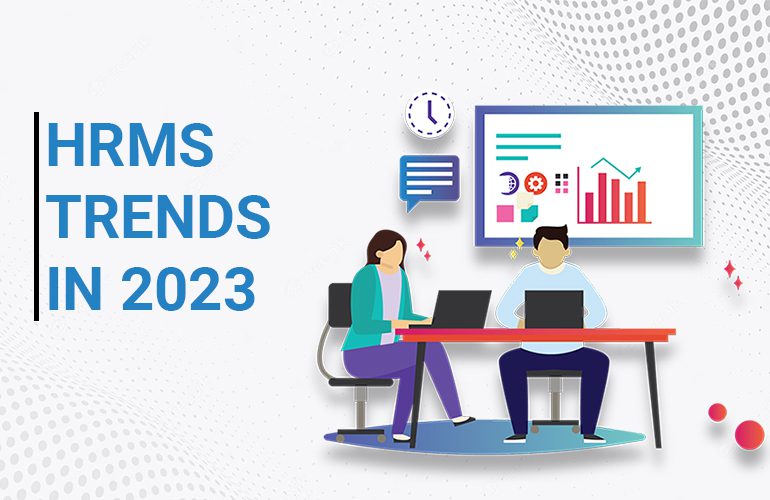The workplace is very different in 2023. The employee-employer relationship has changed due to the pandemic, which started four years ago. Although HR has been at the forefront of crises and change in recent years, there is a chance that it will miss this vital transformation, the future of HRMS, and how HR operates.
The year 2023, represents HR’s best chance to reframe the relevance of the function in the context of the post-pandemic world. Professionals in human resources have been crucial in leading businesses through the pandemic’s aftermath, which included a jump in inflation and an accompanying slump in the economy. Put another way, if HR is given the right tools, it may significantly impact enterprises.
Several HR trends will shape the workplace in 2023. Specific patterns have been developing for a long time, but more recent events have boosted them. Many results from significant adjustments that companies had to undertake and, in some cases, are still dealing with.
Let’s check out what holds for HRMS 2023.
- Future of HRMS and Workforce Ecosystems
While HR has typically concentrated on permanent employees, alternative worker types, including contractors, gig workers, and employees working for supply chain partners, play an increasingly crucial role in the company’s service delivery.
ADP estimates that one in every four employees in 40% of organizations work as gig workers. As a result, a significant portion of the entire workforce is not managed, and HR loses out on a chance to have an impact.
The complex workforce environment outside of permanent employees will be managed by HR starting in 2023. There are three effects of this.
First, HR will actively participate in overseeing its contingent staff. The HR value chain will incorporate independent contractors, gig workers, and outside contributors.
Second, by enhancing the value of external contributors in today’s platform economy, HR may help to develop a more integrated labor ecosystem.
Third, HR should collaborate with vendors, service providers, and partners in the supply chain to exchange best practices.
Value chains are significant from both a production and a reputational standpoint, as demonstrated by the (post-)pandemic era.
Although it’s possible that HR doesn’t influence partnership choices, it does have an extraordinary chance to improve best people practices across the supply chain.
Examples of projects that we anticipate expanding in 2023 include the development of expert communities, mentoring programs for seasoned HR professionals, and job rotation throughout the supply chain.
- HR Steps Into The Metaverse.
By 2026, 25% of people, according to Gartner, will spend at least an hour each day in the metaverse. Hence, some initiatives, such as virtual events, employee onboarding, career fairs, and meetings, will be underway at the top firms in this field in 2023.
The metaverse may also be used for professional development and training. To increase learning accessibility through the metaverse, Meta is investing $150 million in developing an immersive learning ecosystem.
The small number of companies already taking advantage of the metaverse’s possibilities will stand out as more contemporary employers, engage candidates better when they apply remotely, and even increase productivity.
A few businesses will distinguish themselves in 2023 by investing in the metaverse. There will be inventive little firms using virtual workspace software and giant corporations with specially created metaverse environments.
The metaverse allows for reimagining a creative, collaborative, and productive world without being restricted by physical conventions. Moreover, the absence of physical conventions expands the potential for disability inclusion.
- Including Employees At All Stages Of Their Careers
More people are becoming aware of diversity, equity, inclusion, and belonging (DEIB).
The expansion of HR’s efforts to create more inclusive HR practices is one of the critical trends in HRMS for 2023.
Diversity programs currently place a lot of emphasis on hiring. HR businesses are now examining the complete employee life cycle through a DEIB lens.
DEIB provides a chance to link diversity programs with the organization’s mission. This is not only morally correct but also makes good business sense.
Developing HR practices from a diversity viewpoint is another area with a growing emphasis on training HR staff.
A helpful first step toward developing trust and putting policies that assist those with disabilities into place is to provide a comfortable environment for employees to reveal their difficulties.
In 2023, HR will actively locate and monitor the appropriate DEI measures.
- Redefining Workplace Learning
Also, HR will update employee development plans in 2023 and integrate learning into regular tasks.
According to a McKinsey analysis, lack of career development and progress is the leading cause of leaving a job amid the Great Resignation and the Great Reshuffle. However, only 40% of employees feel their firm is upskilling, even though 87% of organizations are aware of or will experience a skills gap in the upcoming years.
More strategic learning, or developing skills in line with the capabilities a business needs to be competitive, will be the focus in 2023. These can comprise both soft skills, such as communication, time management, and analytical and critical thinking abilities, as well as hard skills, which are more technical.
- An Emphasis On Overall Health
Organizations are experiencing a quiet crisis. The American Psychological Association (APA) reports that over 3 out of 5, workers experienced adverse effects from workplace stress following the pandemic. 87% of Americans are concerned about inflation, and 7 out of 10 workers are concerned that their pay hasn’t increased in line with changes in purchasing power.
The pandemic, which caused the HR function to play a significant role, has had a negative impact too. A startling 98% of HR professionals say they have experienced burnout at some point in the last six months, according to research.
HR prediction for 2023 is that firms will be more accountable for the impending catastrophe of employee burnout across the board.
First, it is the proper thing to do, and second, it jeopardizes the organization’s viability.
HR will need to first deal with its burnout crisis.
Next, we anticipate HR to adopt a more proactive stance toward resilience and well-being. This entails creating a more all-encompassing strategy for employee welfare that prioritizes their mental, physical, and financial health.
Overall, starting with its welfare, HR will pay attention to several facets of well-being in 2023.
Last Thoughts
The future of HRMS is full of tremendous opportunities. However, there are a lot of obstacles to go beyond.
HR must first put their own needs first and keep strengthening their resilience. This will put HR practitioners in a better position to improve employee welfare and assist firms in preparing for new challenges.
Second, firms must embrace a broader viewpoint and recognize that HR trends affect the entire company, not just one department. They need to consider how HR can be crucial to managing organizational change. To effectively manage the changes in the workplace, business executives and HR must work closely and acutely together.
Thirdly, companies must acknowledge that we are on the verge of a new era that puts people’s needs first and views enterprises not only as frameworks for optimizing efficiency and profit but also as sources of meaning for their varied, empowered, and engaged workforces.
It’s time for HR to stand up, seize the opportunities that 2023 will bring, and redefine the function’s value proposition as a business leader and creator of competitive people skills. Driving strategic impact through people is HR’s fundamental strength.










